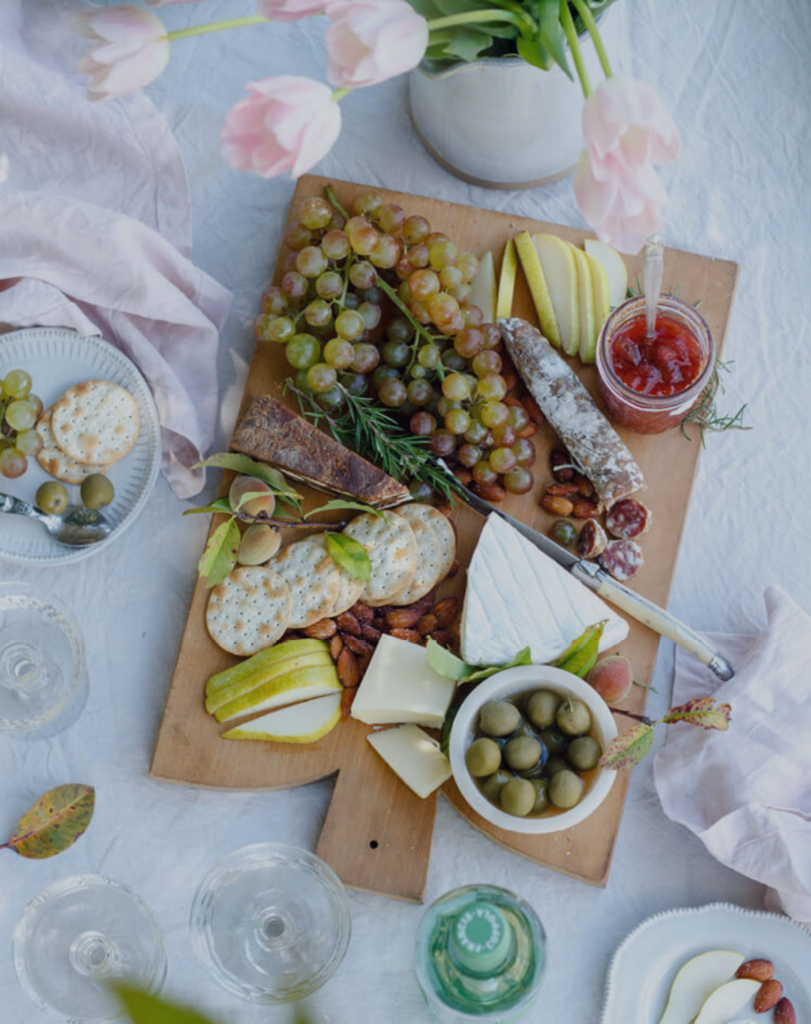Yogurt & Granola Breakfast Board
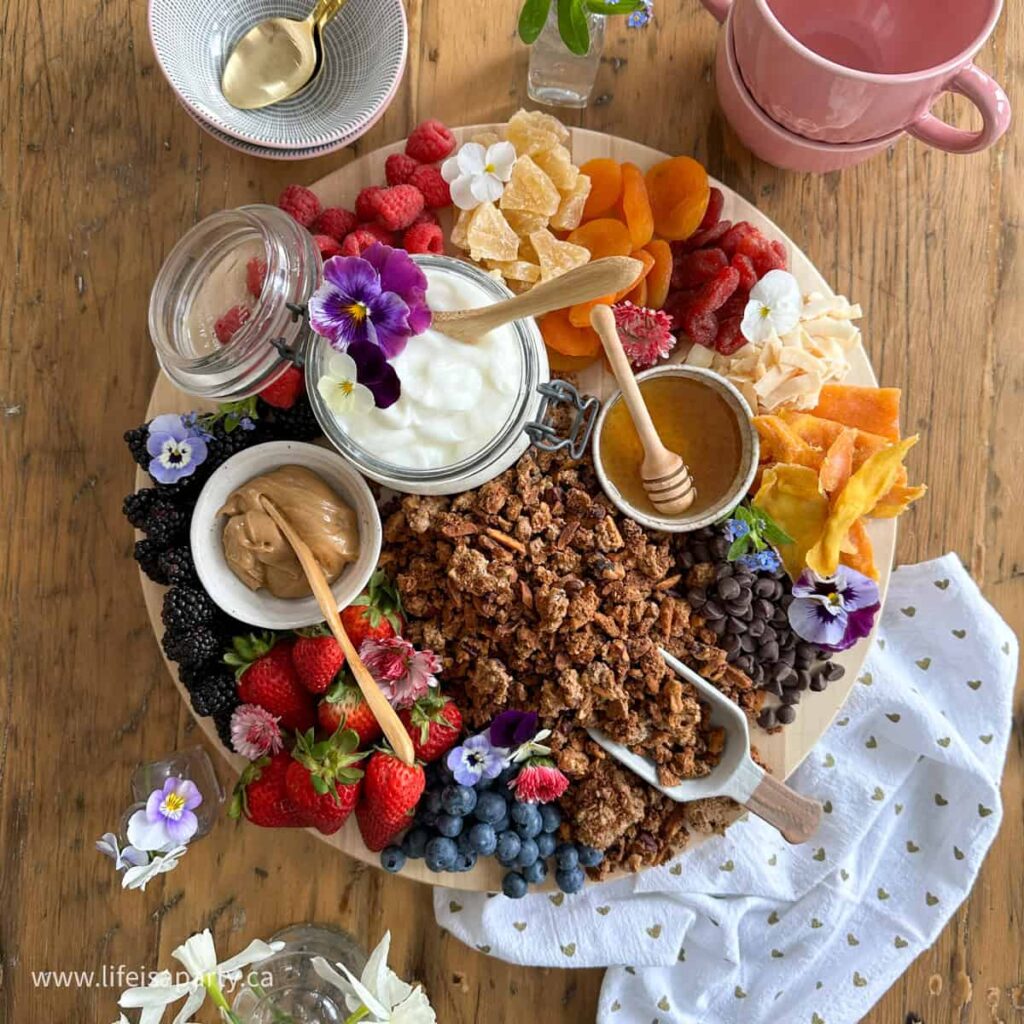


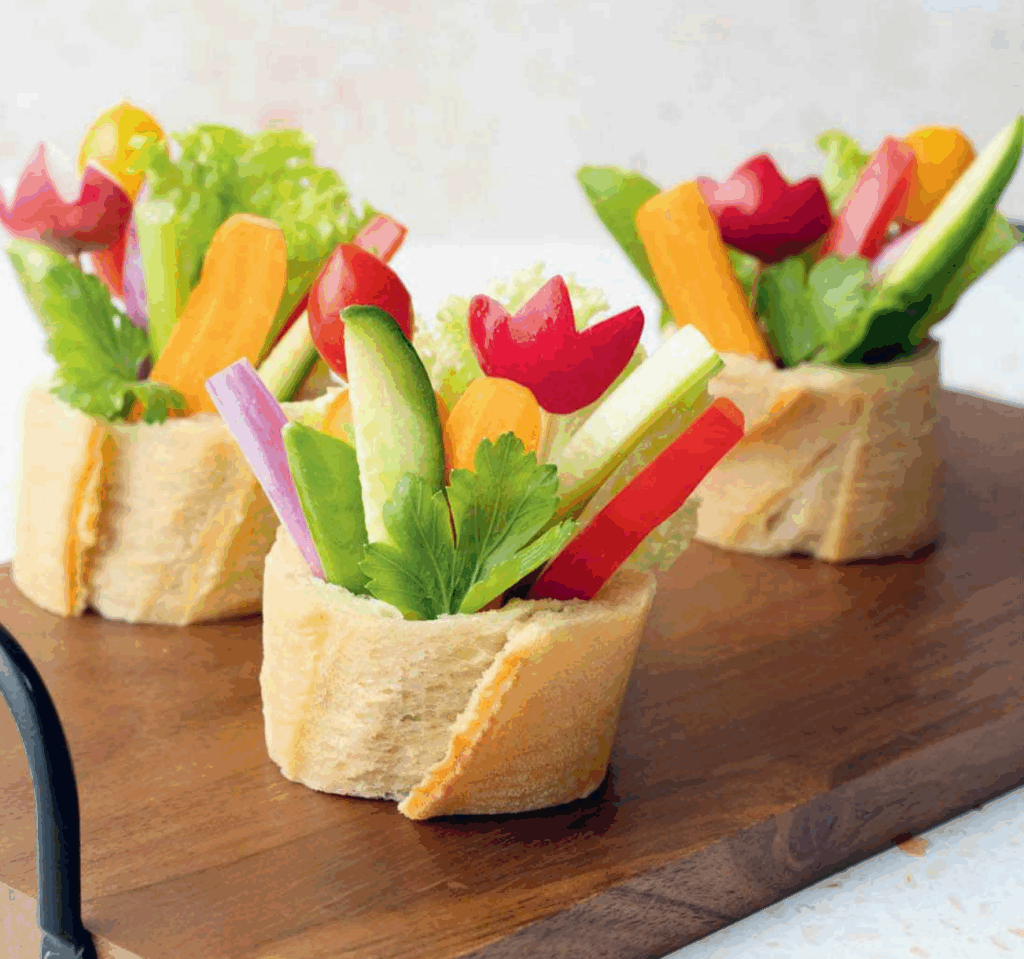
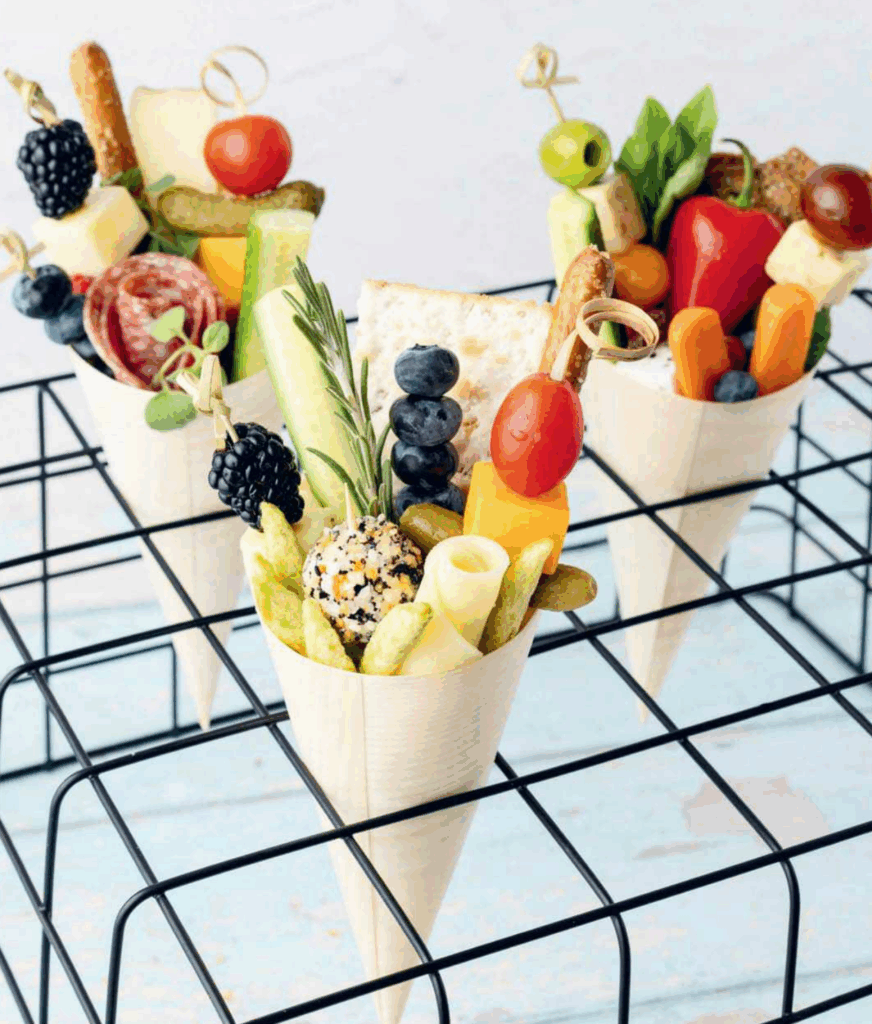
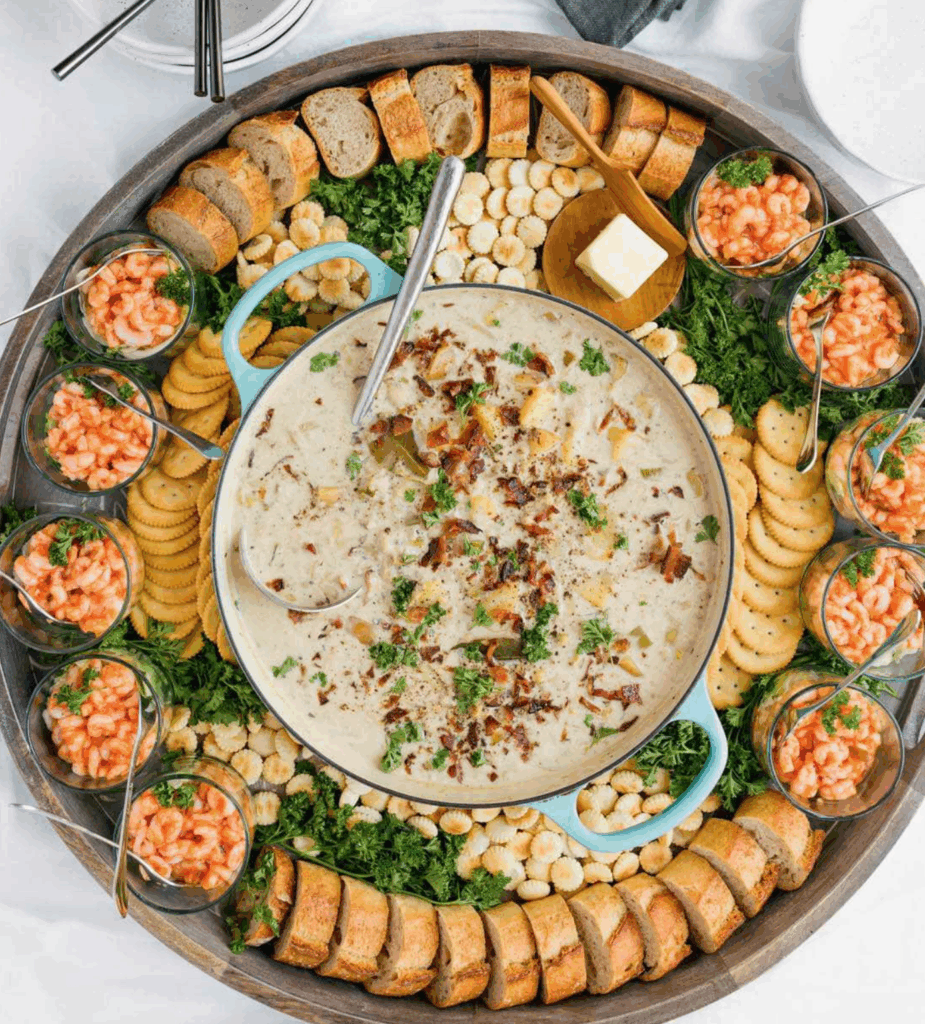 Clam Chowder Board
Clam Chowder Board
26-inch (66-cm) food board
Clam Chowder
5 cups (150 g) shredded lettuce
2 pounds (908 g) baby shrimp
1 cup (240 ml) cocktail sauce
Parsley, for garnish
2 baguettes, sliced
¼ cup (60 g) unsalted butter
3 cups (150 g) oyster crackers
6 ounces (168 g) Ritz crackers
Place a hot pad in the center of the board for the clam chowder. To make the shrimp cocktails, add a 1/2 cup (15 g) shredded lettuce to 10 small cups. In a medium bowl, add the shrimp and cocktail sauce and gently stir, being careful not to break the shrimp. Add 1/3 cup (80 g) of the shrimp cocktail mixture on top of the lettuce. Add a sprig of parsley to garnish. On the inside edge of the board, on either side, place 5 shrimp cocktails. In between the shrimp cocktails, on the inside edge of the board, fan the baguette slices. Place a small bowl with the butter nearby. In a circular pattern, fan out the Ritz crackers, then add oyster crackers. Garnish any open spaces with the parsley.
 Garlicky Hoisin Mushrooms
Garlicky Hoisin Mushrooms
24 oz. whole button mushrooms, trimmed
1 small sweet onion, halved, sliced
1/4 cup of water
3 cloves garlic, minced
2 T., gluten-free soy sauce or Bragg’s liquid aminos
1 T., smooth natural peanut butter
1 tsp. rice wine vinegar
1 tsp. sesame oil
1/4 tsp. crushed red pepper
Spray crock with non-stick spray. Place mushrooms and onions into the crock. In a bowl, mix together the water, garlic, soy sauce, peanut butter, rice wine vinegar, sesame oil, and crushed red pepper. Pour this mixture over the mushrooms and onions. Cover and cook on low for 5-6 hours. To serve, stir the mushrooms gently through the sauce, then remove with slotted spoon. Serve with toothpicks. Optional: Garnish with diced scallion and sesame seeds.

Sheet Pan Banana Pancake Breakfast Board
24 to 26-inch (60-66 cm) food board
Sheet-Pan Banana Pancake (recipe follows)
11/2 T. (23 ml) olive oil
12 eggs, beaten
11/2 tsp. kosher salt
1/2 cup (60 g) grated sharp Cheddar cheese
1 T. (5 g) chopped scallion, for garnish
1 package (20 ounces, or 560 g) maple breakfast sausage, cooked
1 cup (240 ml) heavy cream
1/4 cup (30 g) powdered sugar
1/2 tsp. vanilla extract
2 pounds (908 g) strawberries
1 pound (454 g) blueberries
1 cantaloupe, cut into 2-inch (5-cm) pieces
Mint, for garnish
2 ¼ cups (540 ml) buttermilk
½ cup (120 g) Greek yogurt
2 eggs
¼ cup (60 ml) water
2 ½ tsp. (12 ml) vanilla extract, divided
2 tsp. (10 g) kosher salt, divided
¼ cup (50 g) granulated sugar
½ cup plus 2 T. (125 g) packed dark brown sugar, divided
2 ¼ cups (270 g) all-purpose flour
1 tsp. baking powder
1 ¼ tsp. baking soda
1 tsp. cinnamon
1 T. (15 ml) maple syrup
¼ cup (60 g) unsalted butter
8 ounces (224 g) bacon, cooked
3 to 4 bananas, peeled and quartered
BOARD ASSEMBLY: Place 3 hot pads or trivets on the board to hold the pancake. Place a large bowl on the board to hold the scrambled eggs and a medium bowl to hold the sausages. Place a hot pad or trivet underneath each bowl. Heat the oil in a large nonstick skillet. Pour in the eggs and sprinkle with the salt and cheese. Cook, scrambling, until just set and no longer wet. Pour into the bowl, scatter the scallions on top, and cover to keep warm. Cook the sausage according to package directions, place in a medium bowl, set on the board, and cover to keep warm. In a bowl using a mixer, whip the cream for 2 to 3 minutes until thick; add the powdered sugar and vanilla. Gently mix, transfer a medium bowl, and place on the board. Fill in the spaces with the strawberries, blueberries, and cantaloupe and small sprigs of mint. For the Pancakes: Preheat the oven to 500°F (250°C, or gas mark 10). Coat a 13 x 18-inch (3 3 x 46-cm) baking sheet with nonstick spray on the bottom and the edges (important for ensuring your pancake flips out of the pan). Place a piece of parchment on the bottom of the sheet pan and set aside. In a large mixing bowl, whisk together the buttermilk, yogurt, eggs, water, 2 tsp. (10 ml) of the vanilla, 11/2 tsp. (8 g) of the salt, granulated sugar, and 2 T. (25 g) of the brown sugar. Set aside. In a separate bowl, combine the flour, baking powder, baking soda, and cinnamon. Set aside. In a small saucepan, combine the remaining 1/2 cup (100 g) brown sugar, remaining 1/2 tsp. (2 ml) vanilla, remaining 1/2 tsp. (2 g) salt, maple syrup, and butter. Cook over medium heat, stirring, until the sugar begins to bubble. Remove from the heat and spread evenly onto the parchment-lined baking sheet. Lay down the bacon and bananas on the brown sugar mixture in diagonal rows, alternating bananas and bacon. Pour the flour mixture into the wet ingredients and whisk together. Small clumps are okay; do not overmix. Spread the batter over the bacon and bananas, gently smoothing the top. Immediately place in the oven and reduce the temperature to 400°F (200°C, or gas mark 6). Bake for 15 to 18 minutes, or until a cake tester comes out clean and the top of the pancake is lightly browned. Remove from the oven and let cool for 3 to 4 minutes. Using a sharp knife, carefully cut around the edges to ensure the pancake releases. Flip the pan upside down onto a large platter or cutting board. Remove the pan and gently pull the parchment off. Cut the pancake into squares, arrange on a platter, and keep warm until ready to serve, then place on the board.
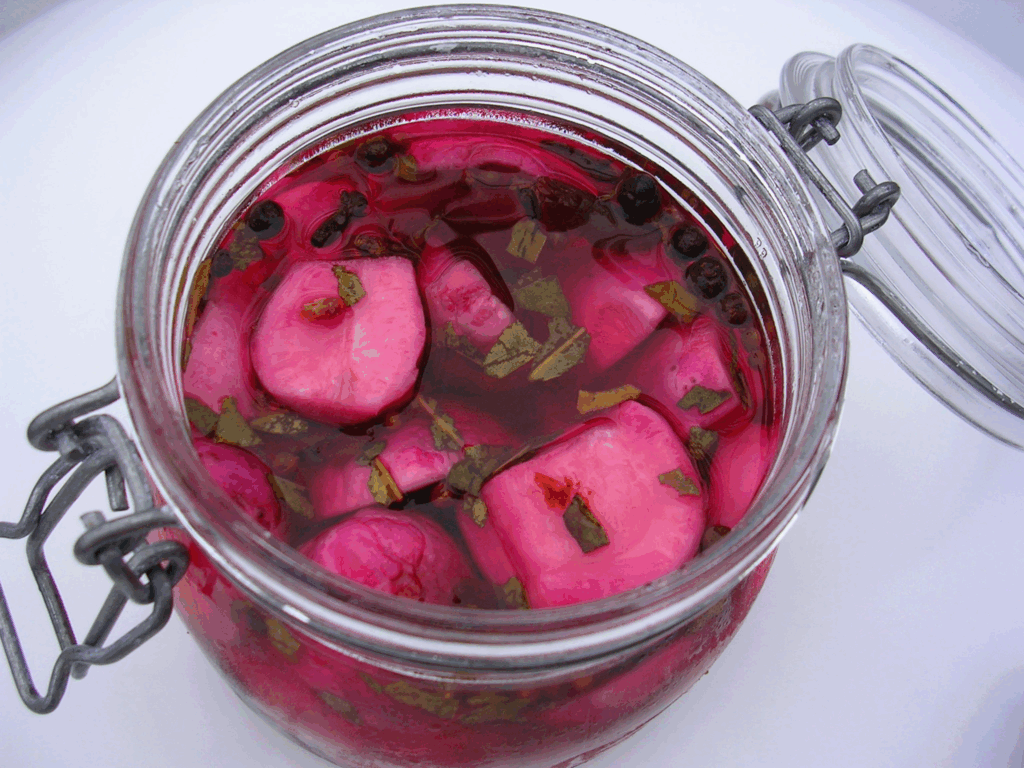 Pickled Sweet-and-Sour Radishes
Pickled Sweet-and-Sour Radishes
1 large bunch radishes (12 if big, 20 if small)
½ cup white wine vinegar
¾ cup sugar
1½ tsp. salt
3 tsp. pickling spice
Remove the leaves, root end and root hairs from the radishes. Brush under cold water and dry. Leave the radishes whole if very small, or half/quarter them depending on size. I prefer cutting them to make sure they don’t contain any worms. Pack in a jar with a tight-fitting lid. Place the jar on a folded damp kitchen towel (that prevents it from cracking when you add the hot liquid). In a small pot, bring vinegar, sugar, salt and pickling spice to a boil, scraping down the sides and stirring, until the sugar is fully dissolved. Pour the hot liquid with the spices over the radishes. They should be fully immersed; add more vinegar and sugar in the same ratio if needed. Let cool, then close the jar tightly. Refrigerate for a day before eating.
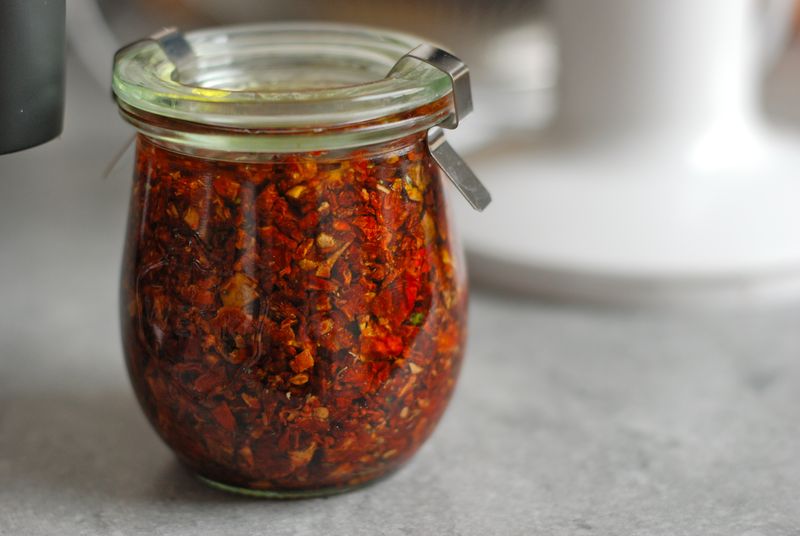 Capuliata
Capuliata
Find yourself some sun-dried tomatoes. My most recent batch of capuliata came from 8 1/2 ounces of sun-dried tomatoes (240 grams). Put them in a food processor and pulse them until they are finely chopped. According to taste, add a healthy pinch of dried oregano and/or a dried chile to the processor before pulsing. Wash and dry some jam jars (I was able to fill two). Fill the jars with the chopped tomatoes. You may have to push them down a little, but do not stuff the tomatoes into the jar too hard. Pour good-quality olive oil into each jar, pausing halfway through for the oil to slither into all the nooks and crannies, until the capuliata is covered with a thin film of oil. Close the jars. Store in a cupboard for up to a year (no need to refrigerate after it’s been opened, as long as there’s always some oil on top). But what do you do with capuliata, I can hear you asking. Well, you can use it as a crostino topping, or dollop it alongside some cured meats for an antipasto. You can use a few spoonfuls to dress pasta, along with copious amounts of chopped parsley and grated pecorino. You can spread a dollop of it on a nice crusty sandwich along with something smooth and cool to calm down the flavors, like ricotta (I’d add some arugula, too).
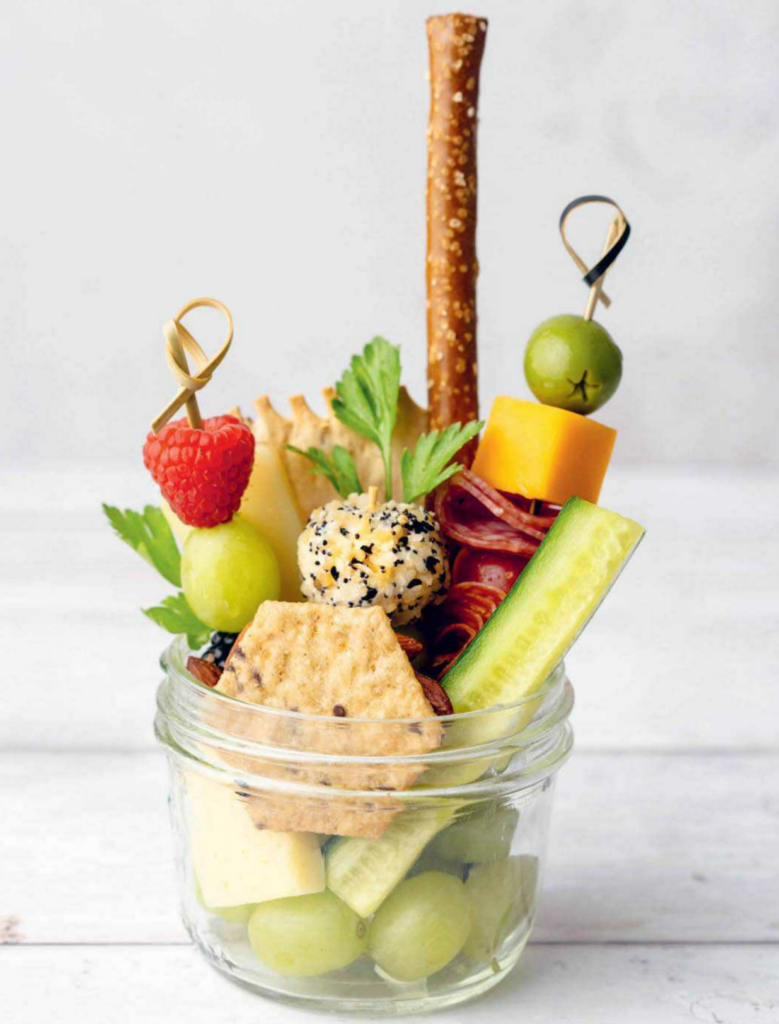 The Classic Jarcuterie
The Classic Jarcuterie
SUPPLIES
4 jars, 8 ounces (240 ml) in size
4 knotted flat skewers, 6 inches (15 cm) long
4 knotted flat skewers, 4 inches (10 cm) long
4 toothpicks, 4 inches (10 cm) long
SALAMI SKEWERS
4 pitted Castelvetrano olives
4 cubes mild Cheddar cheese
4 slices regular salami, quarter-folded
4 grape or cherry tomatoes
4 slices spicy salami, quarter-folded
FRUIT SKEWERS
4 raspberries
4 grapes
4 blackberries
EVERYTHING BAGEL CHEESE TRUFFLE SKEWERS
4 Everything Bagel Cheese Truffles
ADDITIONAL INGREDIENTS
4 La Panzanella Mini Croccantini Artisan Crackers
4 pretzel rods
16 to 20 grapes
4 wedges cucumber
4 squares Havarti cheese
4 multigrain crackers (such as Crunchmaster Multi-Grain Baked Crackers)
4 triangles Manchego cheese
3 to 4 T. (25 to 35 g) roasted almonds
4 to 8 sprigs fresh herbs, for garnishing
To assemble the salami skewers: Thread the 6-inch (15 cm) knotted skewers each with an olive, a cheddar cube, a quarter-folded slice of regular salami, a tomato, and a quarter-folded slice of spicy salami. Set aside. To assemble the fruit skewers: Thread the 4-inch (10 cm) knotted skewers each with a raspberry, a grape, and a blackberry. Set aside. To assemble the everything bagel cheese truffle skewers: Thread the 4-inch (10 cm) toothpicks each with an Everything Bagel Cheese Truffle. Set aside. To assemble the jars: Place a La Panzanella cracker and a pretzel rod in the back of each jar, and then add four or five grapes to the base. Insert a salami skewer in the back right and a fruit skewer in the back left. Place the cucumber wedge at an angle in front of the salami skewer and the Manchego triangle, with the point down, behind the fruit skewer. Place a Havarti square in the front left and a multigrain cracker in the front middle. Place an everything bagel cheese truffle skewer in the middle on top. Fill in gaps with the roasted almonds and garnish with the fresh herbs.
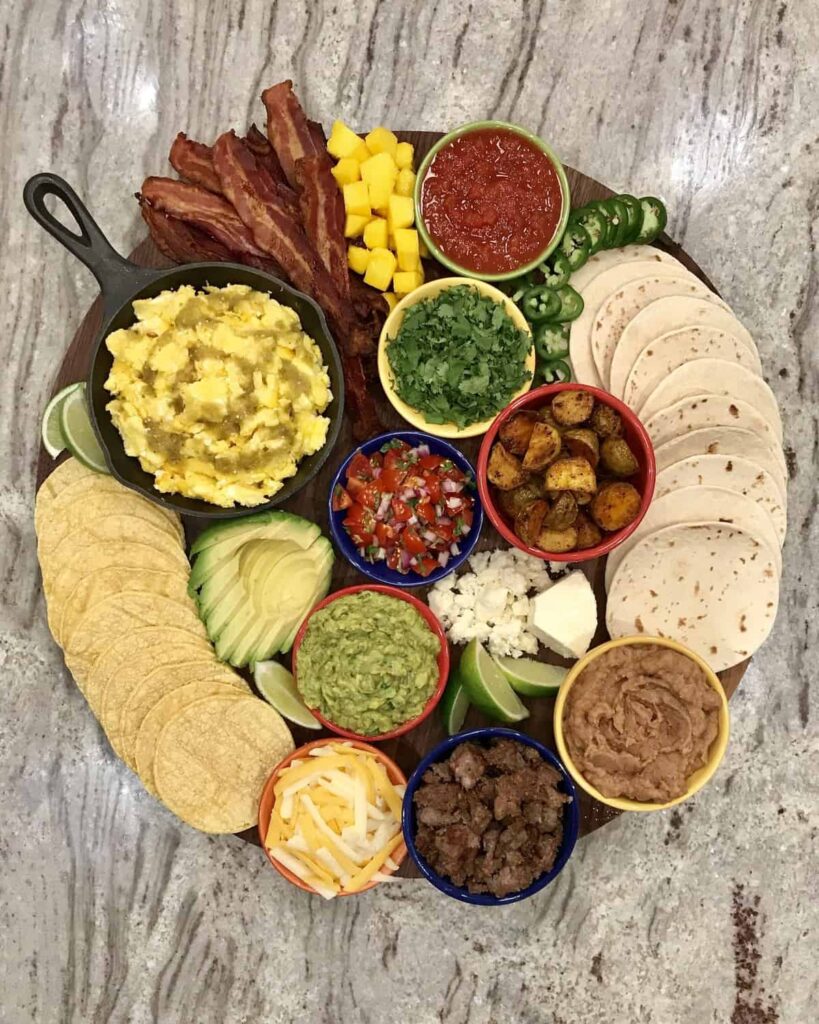
Build-Your-Own Breakfast Taco Board
Salsa Verde (to top on eggs)
Baked Bacon
Refried Beans
Breakfast Sausage
Breakfast Potatoes
Corn Tortillas
Flour Tortillas
Avocado (diced)
Guacamole
Cotija Cheese
Shredded Cheese
Cilantro
Sliced Jalapeno
Lime Wedges
Diced Mango
Make the baked bacon and guacamole. Slice the jalapeños, dice the mango, wedge the limes, chop the cilantro, and slice or dice the avocado. Place all of the cold and room temperature toppings in bowls and on the board. Brown the breakfast sausage. Make or warm the breakfast potatoes. Warm the corn and flour tortillas on a griddle or in the microwave. Scramble the eggs and heat up a can of refried beans. When ready, add the eggs to a cast iron skillet for serving on the board and top with salsa verde. Fill serving bowls with the breakfast sausage, potatoes and refried beans.
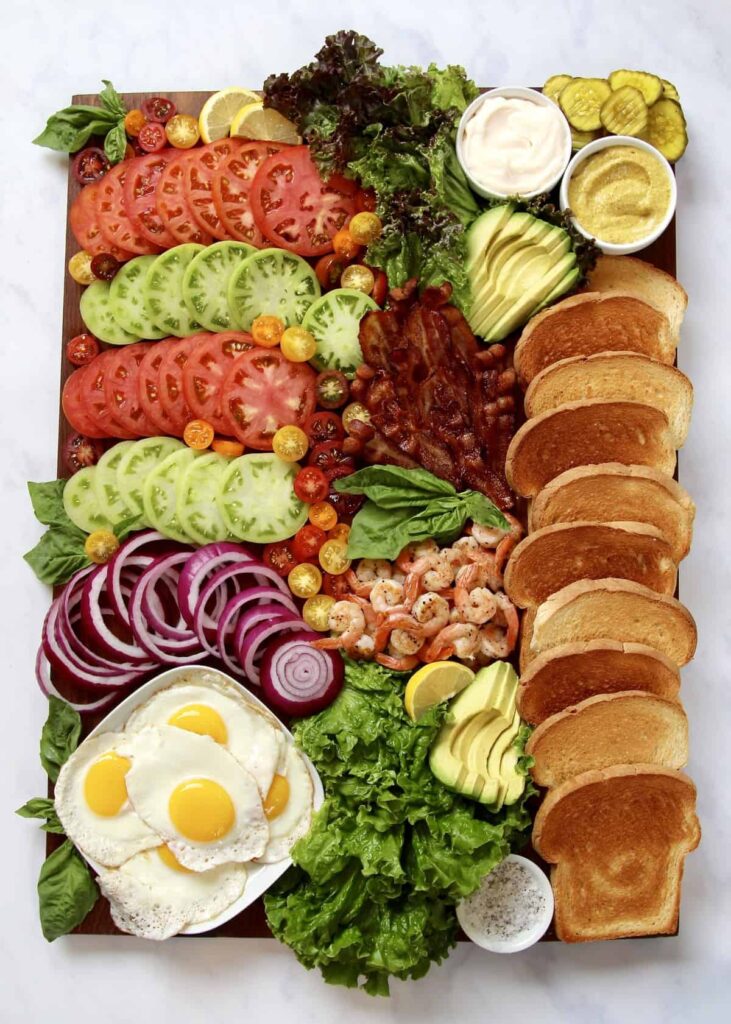 Build-Your-Own BLT Board
Build-Your-Own BLT Board
Sliced Sandwich Bread (toasted)
Bacon
Lettuce
Tomatoes
Mayonnaise
Dijon Mustard
Sunny-Side-Up Eggs
Avocado (sliced)
Red Onions (sliced)
Sautéed Shrimp
Pickles
Basil
salt and pepper
Start by baking the bacon and toasting the bread. You can toast the bread all at once by lining up the slices of bread on a baking sheet, and baking them at 400ºF for 6-8 minutes, turning halfway through. While the bread and bacon are in the oven, slice the tomatoes, onion, and avocado and prep the lettuce. After the bread is toasted and the bacon is done, start cooking the eggs and the shrimp. You can boil, grill, or pan-fry the shrimp to your liking with a simple seasoning of salt and pepper. Arrange the rest of the ingredients on a wood board. Try to keep the bread away from some of the juicier ingredients, like tomatoes and pickles, and make sure to dry the lettuce well so that it doesn’t get soggy before everyone starts building their own sandwiches. Serve and enjoy!
 Charcuterie Board Cracker Bites
Charcuterie Board Cracker Bites
24 large round and rectangle entertaining crackers
¼ C. (60 g) fig jam spread
1 round (8 ounces, or 227 g) double-cream Brie, sliced into 24 small wedges
1 block (7 ounces, or 198 g) aged white Cheddar, crumbled into small chunks
12 thin slices soppressata, cut in half and rolled up tightly
6 thick slices hard salami, cut into quarters
6 dried apricots, cut into quarters
24 Marcona almonds
24 whole glazed pecans
12 cornichons
6 pitted kalamata olives, cut in half
24 small sprigs fresh rosemary, for garnishing
Honey with dipper, for drizzling
Spread each cracker with ½ teaspoon of the fig jam. Arrange a Brie wedge and some crumbled Cheddar on each cracker. Place a soppressata roll-up and a quarter of hard salami on each cracker. Fill in each cracker with an apricot quarter, Marcona almond, glazed pecan, and a cornichon or olive half. Garnish each cracker bite with a little sprig of rosemary. Serve with honey for drizzling.
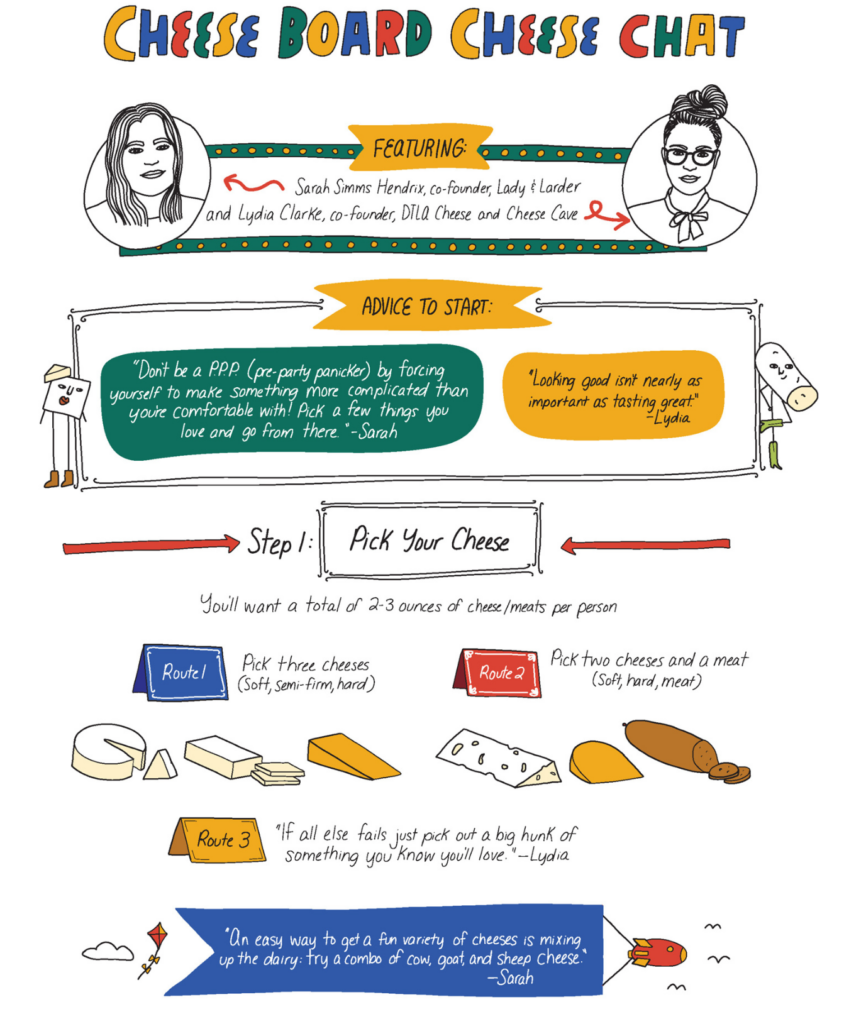
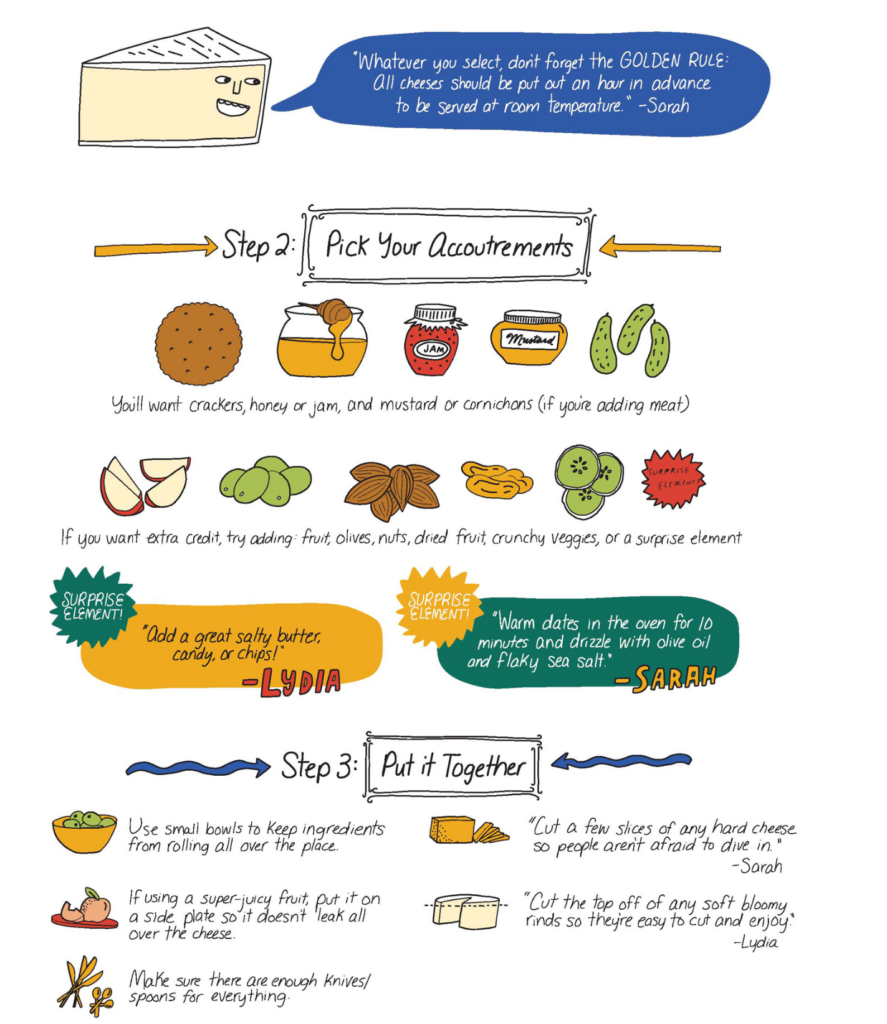

 Easy Fried Halloumi Recipe with Warmed Honey
Easy Fried Halloumi Recipe with Warmed Honey
extra virgin olive oil
8 ounces Halloumi cheese, pat dry and cut into ½-inch sticks
¼ cup honey
2 tablespoons toasted sesame seeds
crushed red pepper flakes (I used Aleppo pepper)
In a non-stick pan, heat 2 tablespoons extra virgin olive oil over medium-high heat.
When the oil is hot and shimmering, add the halloumi sticks in one single layer, making sure not to crowd the pan. Cook for 1 to 2 minute on one side, until a golden brown crust forms. Using a pair of tongs, turn over and cook for another 1 to 2 minutes watching for that beautiful crust to form. Meanwhile, warm your honey either in a skillet or put your tightly-closed jar in warm water to help the honey loosen a bit. Transfer the fried halloumi to a serving plate and sprinkle with sesame seeds and a dash of red chili flakes or Aleppo pepper. Drizzle with the warmed honey all over (serve unused honey in a small bowl to the side). If you like, arrange some fruit such as grapes, figs, or berries on the same platter around the cheese. Serve immediately!
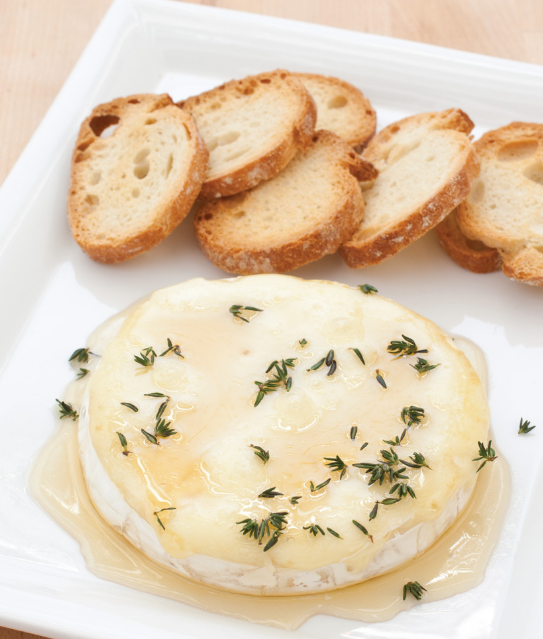 Melted Brie with Honey and Thyme
Melted Brie with Honey and Thyme
1 (8oz) wheel of brie
2 T. of honey
½ tsp. chopped fresh time (reserve sprig fresh thyme for garnish)
Crackers or sliced Baguette
Preheat the oven to 350F. Line baking sheet with parchment paper. Cut the rind from the top of the wheel of the brie. Drizzle honey over the top. Top with sprigs of fresh thyme. Bake the brie in the oven for about 10 minutes until the cheese has completely melted. Serve the baked honey thyme brie warm with crackers or bread. The brie is best eaten immediately but can be reheated and served later.
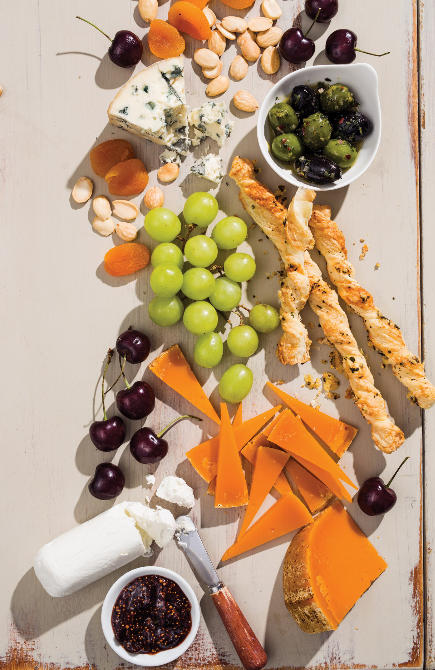 Summer Cheese Board
Summer Cheese Board
A cheese board is an uncontested winner when it comes to easy, elegant entertaining, and makes an especially appealing no-cook option in the summer months. For much of the year, we dress up our board with fruit like apples and pears, jams, and other accompaniments. For a summery take, we opt for lighter additions and in-season fruit like berries and cherries. Choosing the right cheeses and pairing them with complementary crackers, spreads, and other bite-sized goodies is a simple formula to putting together a party centerpiece that everyone is sure to enjoy. But striking the perfect balance of flavors, textures, and aesthetic appeal is something of an art, especially when time is of the essence.
Think about cheeses Start by choosing three to five cheeses with different textures (soft, semisoft, semifirm, hard) and flavors (mild to strong). Include cow’s-milk, goat’s-milk, and sheep’s-milk cheeses, or go with all of one type. Plan on 2 to 3 ounces of cheese per person and let the cheese sit at room temperature, covered, for 1 to 2 hours before serving.
Think about breads Mild-flavored bread such as a baguette and neutral-tasting chips like Pita Chips or wheat crackers won’t overshadow the cheeses.
Think about texture Crisp vegetables like Quick Pickled Carrots can add contrast to soft cheeses. The texture of soft fresh berries and chewy dried fruits works with hard cheeses. Crunchy nuts also add texture.
Think about flavor Select cheese accompaniments that are either complementary, like a mellow caramelized onion relish with a mild fresh cheese, or contrasting, like fruity Fig-Balsamic Jam with a salty, sharp aged cheese.
Think about appearance Fresh cherries and grapes, dried fruits, pickled vegetables, and olives add color as well as texture and flavor.
Marinated Olives
You can buy a wide variety of prepared olive products, but with just a little effort you can put together marinated olives with a lot more flavor and freshness. Make sure to bring the mixture to room temperature before serving or the oil will look cloudy and congealed.
1 cup brine-cured green olives with pits
1 cup brine-cured black olives with pits
cup extra-virgin olive oil
1 shallot, minced
2 tsp. grated lemon zest
2 tsp. minced fresh thyme
2 tsp. minced fresh oregano
1 garlic clove, minced
1/2 tsp. red pepper flakes
1/2 tsp. table salt
Pat olives dry with paper towels. Toss with oil, shallot, lemon zest, thyme, oregano, garlic, pepper flakes, and salt in bowl. Cover and refrigerate for at least 4 hours or up to 4 days. Let sit at room temperature for at least 30 minutes before serving.
Quick Pickled Carrots
These quick-pickled carrot sticks are a cinch to put together and are ready to enjoy in just 3 hours, making them a great introduction to pickling for anyone new to the craft. We love them as a touch of bright color on a cheese board, perfect for popping into your mouth between bites of cheese for a briny, tangy burst of flavor. If possible, choose carrots that are uniform in length. These pickled carrots cannot be processed for long-term storage.
¾ cup seasoned rice vinegar
1/4 cup water
1 garlic clove, peeled and halved
1/8 tsp. black peppercorns
1/8 tsp. yellow mustard seeds
8 ounces carrots, peeled and cut into 1/2-inch-thick sticks
2 sprigs fresh tarragon
Bring vinegar, water, garlic, peppercorns, and mustard seeds to boil in medium saucepan over medium-high heat. Place one 1 -pint jar under hot running water until heated through, about 1 minute; shake dry. Pack carrots and tarragon sprigs into hot jar. Using funnel and ladle, pour hot brine over carrots to cover. Let jar cool completely, about 30 minutes. Cover jar with lid and refrigerate for at least 2 ½ hours before serving. (Pickled carrots can be refrigerated for up to 6 weeks; tarragon will begin to taste funky after 6 weeks.)
Fig-Balsamic Jam
Combining fresh figs with balsamic vinegar and spices makes a sweet-savory jam perfect for cheese and delicious with canapes.
12 ounces fresh figs, stemmed and quartered
1/2 cup sugar
1/4 cup balsamic vinegar
1/4 cup water
1 T. lemon juice
1 tsp. yellow mustard seeds
3/4 tsp. minced fresh rosemary
Pinch table salt
Pinch pepper
Bring all ingredients to simmer in 10-inch nonstick skillet over medium-high heat. Reduce heat to medium-low and cook, stirring occasionally, until rubber spatula leaves distinct trail when dragged across bottom of skillet, 25 to 30 minutes. Transfer jam to food processor and pulse until uniformly chunky, 4 to 6 pulses. Let jam cool to room temperature, about 1 hour, before serving. (Jam can be refrigerated for up to 2 months.)
Cheese Straws
Homemade cheese straws are quick to disappear from a party platter. To thaw frozen puff pastry, let it sit in the refrigerator for 24 hours or on the counter for 30 minutes to 1 hour.
1 (9 1/2 by 9-inch) sheet puff pastry, thawed
2 ounces Parmesan or aged Asiago cheese, grated (1 cup)
1 T. minced fresh parsley
1/4 tsp. table salt
1/4 tsp. pepper
Adjust oven rack to middle position and heat oven to 425 degrees. Line rimmed baking sheet with parchment paper. Lay puff pastry on second sheet of parchment and sprinkle with Parmesan, parsley, salt, and pepper. Top with third sheet of parchment. Using rolling pin, press cheese mixture into pastry, then roll pastry into 10-inch square. Remove top sheet of parchment and cut pastry into thirteen ¾ inch-wide strips with sharp knife or pizza wheel. Gently twist each strip of pastry and space about V2 inch apart on prepared baking sheet. Bake until cheese straws are fully puffed and golden brown, 10 to 15 minutes. Let cheese straws cool completely on baking sheet. (Cheese straws can be wrapped in plastic wrap and stored at room temperature for up to 24 hours before serving.)
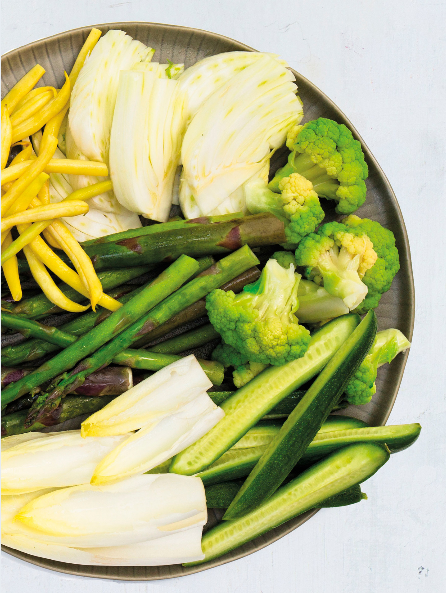 The New Crudites
The New Crudites
The More Color the Better: In late summer, there’s a technicolor spread of in-season produce, from tomatoes and bell peppers to radishes, cucumbers and baby beets. For visuals alone, it’s the best time of the year for crudités.
Don’t Forget About Texture: In case you’ve gotten carried away with color: vary the texture and taste of the assortment, from crunchy carrots and snap peas to lush tomatoes.
Crowd the Platter: Like a good cheese plate, a crudites platter looks best and most appealing when it is full.
Even Fresh Produce Needs Help: Drizzle a little good-quality olive oil on the produce and season with flaky salt, advises Mansell. Dips alongside, a variety of one or two, are also advisable, according to the chef, even if the best produce won’t need them.
Dip Rules: Keep it thick and creamy. Thin sauces like chimichurri or salsas are too loose and drippy, and won’t cling to your veggie sticks. Make it smooth rather than chunky because, again, a chunky sauce won’t cling as well to the slick vegetables and will make for an awkward dipping experience. Feel free to go for bold flavors ~ the veggies can take it!
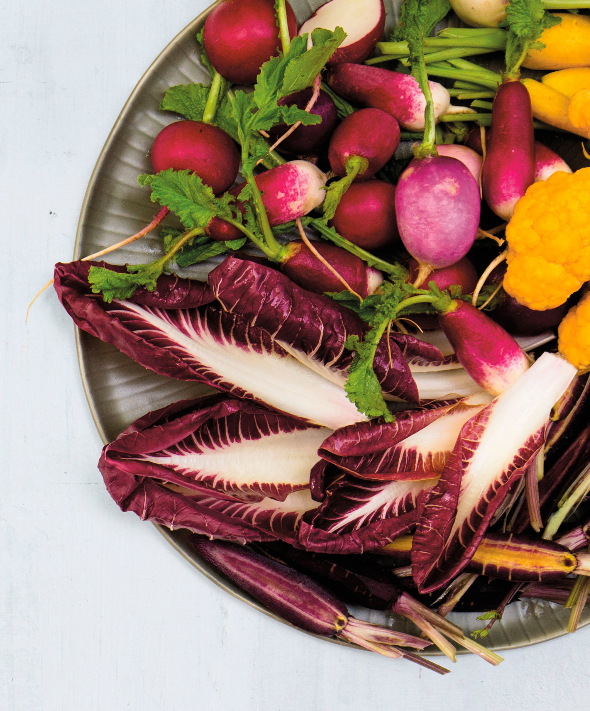
Asparagus (blanch)
Beets (golden, candy cane)
Belgian Endive
Bell Peppers
Broccoli (or broccolini), Cauliflower (try colored varieties), Romanesco
Carrots – Real baby carrots pulled from ground, or rainbow colors
Celery
Cucumber
Fennel
Green Beans, Wax Beans, Romano Beans (serve raw or blanched)
Jicama
Potatoes (halve roasted or boiled fingerlings)
Radishes (look for interesting ones, like French breakfast radish or watermelon radish)
Scallions
Snow Peas / Sugar Snap Peas (blanch. String if necessary)
Summer Squash & Zucchini (Add some Pattypan)
Sunchokes
Tomato (small sizes, like cherry or pear)
Treviso
Turnips

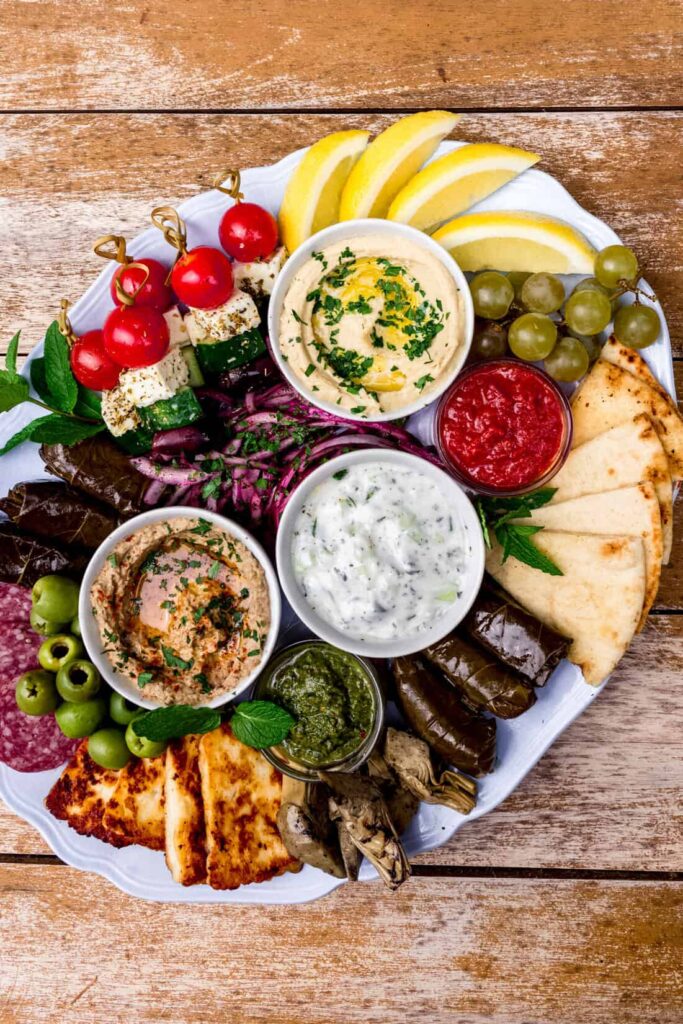
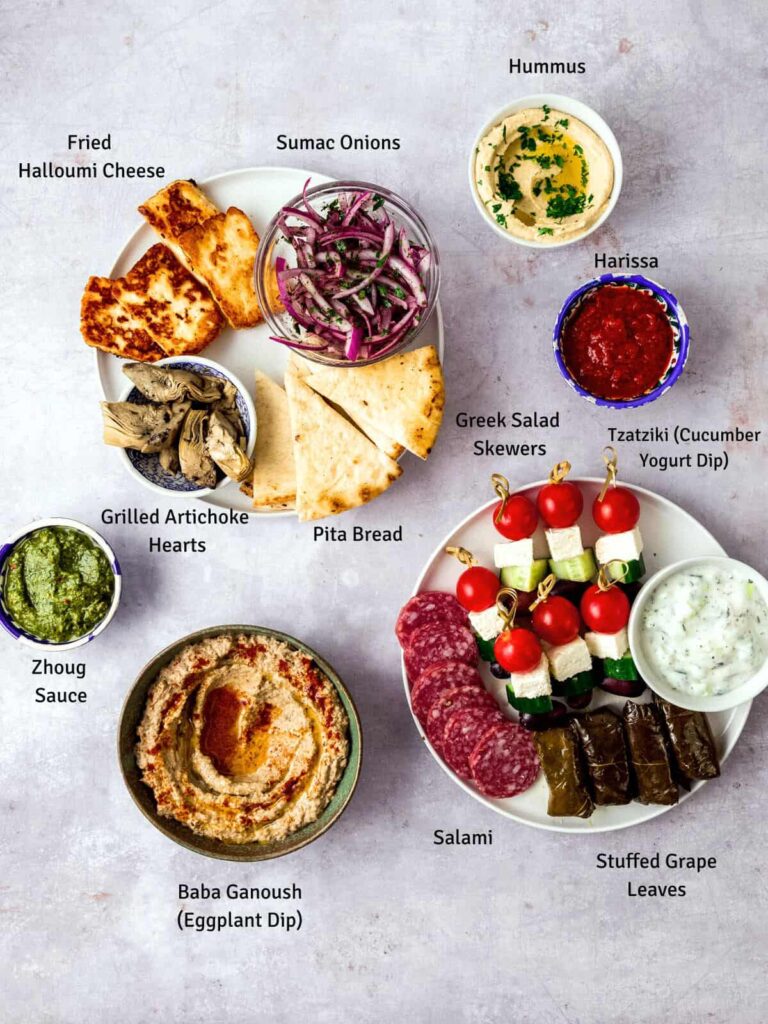
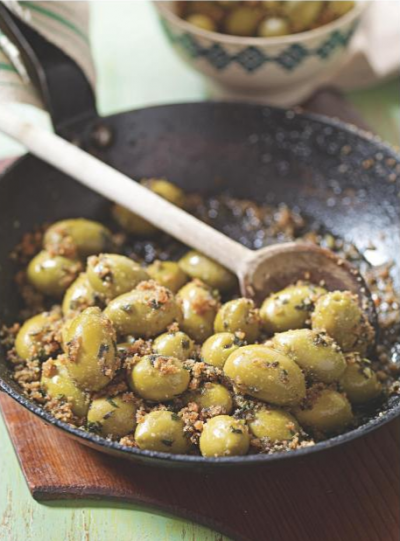 Green Olives with Spicy Breadcrumbs
Green Olives with Spicy Breadcrumbs
1/4 C. extra virgin olive oil
2 T. fresh chopped parsley
1 garlic clove minced
Pinch crushed pepper
2 C. green olives such as Sicilian, drained, rinsed and patted dry
1 T. red or white vinegar
1 C. plain dry breadcrumbs.
IN a medium skillet over medium heat, add the oil with the parsley, garlic, red pepper and cook until fragrant. Add the olives to the pan with the vinegar and cook while stirring until the olives are warm and the vinegar evaporated, about three minutes. With a slotted spoon, transfer the olives to a serving bowl.
Add the breadcrumbs to the pan and cook while stirring constantly, until evenly toasted, about three minutes. Toss the olives with the breadcrumbs and serve warm.
Antipasto – It’s too hot in the kitchen Dinner
 I prefer to prepare a large platter to put in the center of the table, from which all can be used, accompanied by breads, breadsticks, breadcrumbs or carasau breads (lately we prefer the carasau bread, which seems lighter and most of all it is preserved long).
I prefer to prepare a large platter to put in the center of the table, from which all can be used, accompanied by breads, breadsticks, breadcrumbs or carasau breads (lately we prefer the carasau bread, which seems lighter and most of all it is preserved long).
Do not miss garlic, oil and salt : nothing is more good and greedy than a slice of shredded bread with garlic rubbed over and a good goose oil.
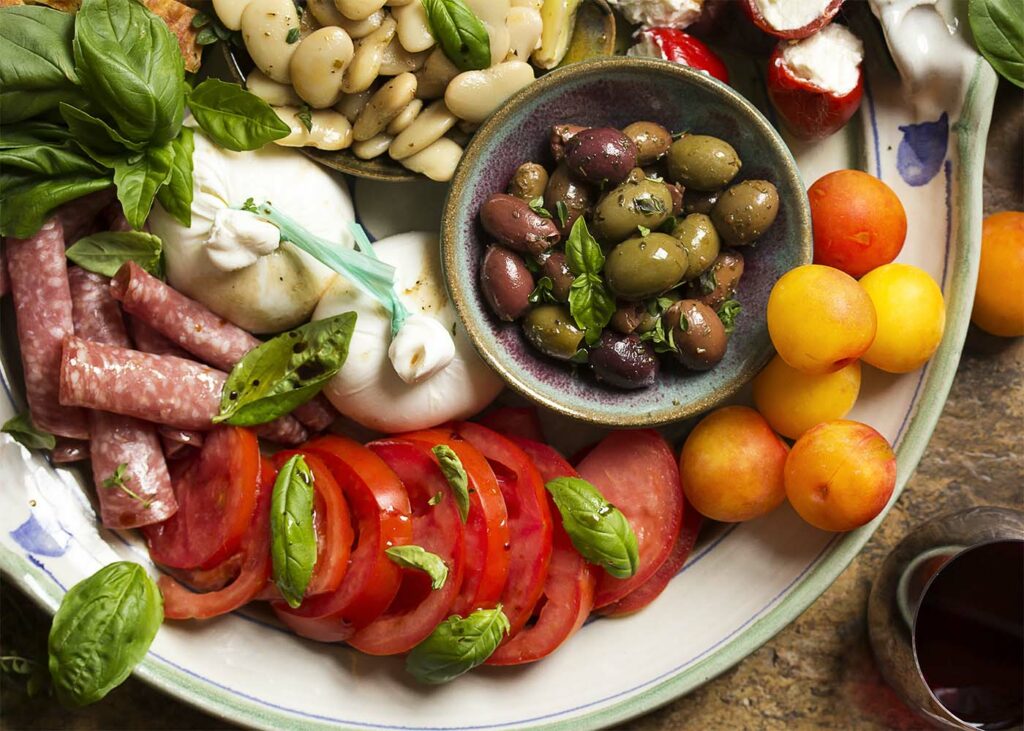
Dried Tomatoes in Oil
olives of various kinds
pickled capers and artichokes
garlic oil
mozzarella, the cherry tomatoes and the basil
celery and raw carrots in the salted greek yogurt and pepper
apples and pears, depending on the season, to be served with Parmesan cheese
grapes, figs
Tropea onions
washed salad leaves, like rocket, valerian, lettuce
yellow and red peppers
roasted mushrooms
Charcuterie Items by Season
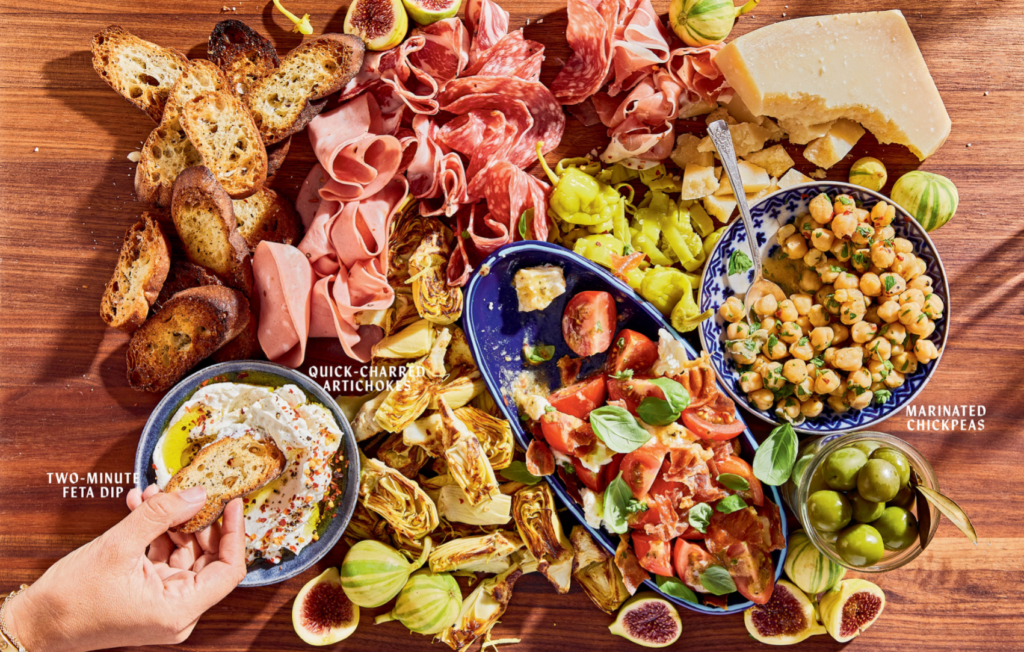
Spring
Raw snap peas
Radishes
Blanched asparagus
Artichoke hearts
Apricots
Kumquats
Grapefruit
Strawberries
Summer
Rainbow carrots
Celery
Broccoli florets
Cucumber
Raspberries
Blueberries
Blackberries
Red or green grapes
Watermelon
Pineapple
Peaches
Plums
Tomatoes of all varieties
Anything growing in the garden!
Autumn
Roasted beets—ruby, striped, or golden
Carrots
Roasted sweet potatoes
Roasted squash
Apples
Pears
Figs
Persimmons
Cranberries
Winter
Pickled beets
Pickled green beans
Dried fruit
Figs
Tangerines
Mandarins
Oranges
Pomegranates
To top off the board and fill in any little gaps, I like to pile on salted or raw nuts, olives, fresh honeycomb, dried fruit, date cakes, and any other sweet and savory bits I may find. Tuck them in and around the other items, letting them spill over which makes it look like a spread fit for royalty. Grainy mustards, honey, chutney, jams, compotes, dips, and preserves are delicious accompaniments to slather on with a slice of cheese and baguette. Pickles, cornichons, pepperoncini, roasted red peppers, and pickled summer vegetables add a briny tang to balance some of the creaminess and sweetness. Use fresh herbs as a vibrant and aromatic garnish too!
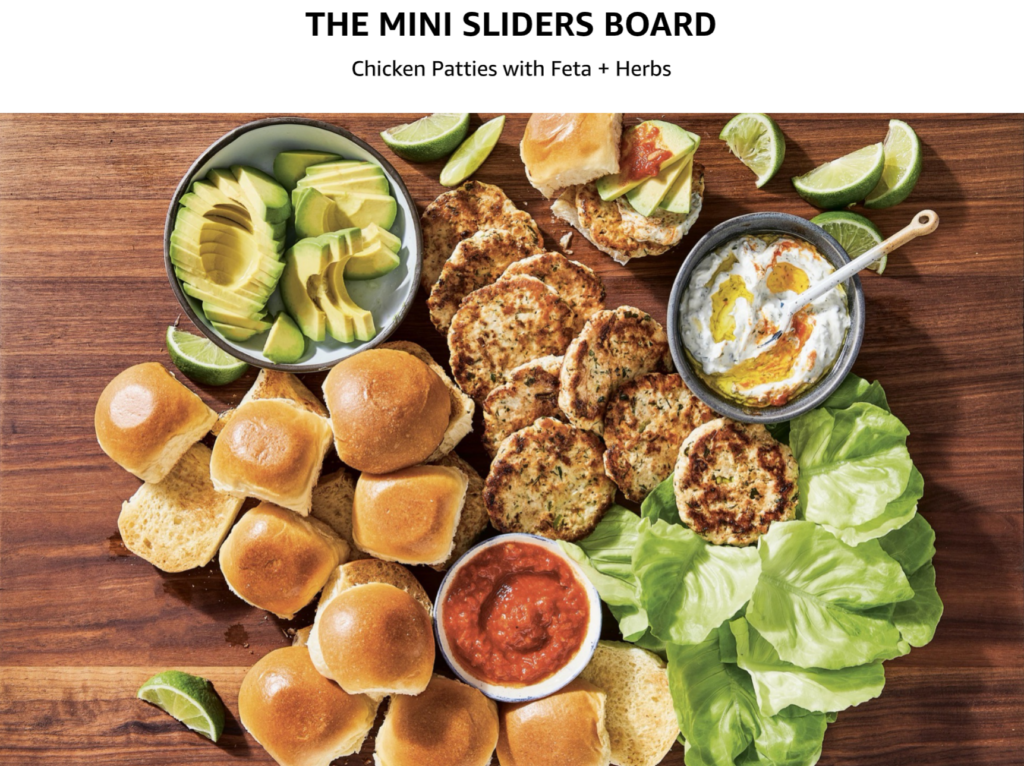
2 medium apples, chopped (2 cups)
2 cups cranberries
1 medium red bell pepper, chopped (1 cup)
1 small onion, finely chopped (1/4 cup)
3/4 cup packed brown sugar
1/2 cup golden raisins
1/2 cup white vinegar
1 1/2 teaspoons finely chopped gingerroot
1 clove garlic, finely chopped
16 slices (1 oz each) assorted cheeses, such as Cheddar, Colby-Monterey Jack, Monterey Jack with jalapeño peppers and Swiss
1/4 cup hazelnuts, (filberts)
Crackers
In 2-quart saucepan, mix all chutney ingredients. Heat to boiling, stirring frequently; reduce heat. Simmer uncovered about 1 hour, stirring frequently, until mixture thickens and fruit is tender. Spoon into nonaluminum container. Store in refrigerator up to 2 weeks. Cut cheese with 1-, 1 1/2- and 2-inch leaf-shaped cookie cutters. Place cheese on medium platter, overlapping leaves. Sprinkle hazelnuts on platter to look like acorns. Serve with chutney and crackers.
An antipasto come before the meal (il pasto), and its function is to prepare the stomach for the courses. So the antipasto is to be merely tasted, savored slowly in minimal amount rather than devoured. Otherwise it takes the place of the meal, becoming an epilogue instead of a prologue.
There are many different kinds of antipasti. They follow one general rule, which is that hot ones are served before a reasonably light meal, cold ones before a substantial meal. Also, they must have a certain harmony with the rest of the menu – they should bear some relationship to the dishes that follow. The visual element of antipasti dishes is important so that the appetite is stimulated in the imagination even before it is stimulated by the taste. A skillful blending of colors and garnishes is all part of the exercise: preparing a plate of antipasti is like playing with a puzzle.
Most of the recipes have one indispensable ingredient in common: extra virgin olive oil.
Just as olive trees have been constant feature of Tuscan landscape for thousands of years, so olive oil has always played leading role in Tuscan cooking. There is an old saying that wine lift the spirits and oil lift the taste, which confirm the dominant role of olive oil in the kitchens of peasant and aristocrat alike. Bruschetta and raw vegetable dip pinzimonio cannot be the same without the unmistakable taste of extra virgin olive oil!
Â
A platter of Mediterranean-style savory bites that partners well with predinner drinks at holiday gatherings. It is an easy option for cocktail parties, open houses, and lunch buffets, too, because many of the items can be store-bought.
Â
Start with a visit to a good deli or specialty-foods store to find ready-made items like olives; specialty nuts, such as Marcona almonds; artisanal cheeses, such as pecorino, Manchego, mozzarella, and fresh goat cheese; spreads, such as tapenade; and cured meats, including prosciutto, salami, mortadella, and coppa. Serve four to six items, and plan on 1 to 2 ounces (30 to 60 g) of each per guest. You can supplement these offerings with raw or roasted vegetables with a Mediterranean-style dipping sauce.
Assembly
Â
Choose an attractive tray, platter, or cutting board. Or, create a dramatic presentation using a long, narrow platter, a tiered charcuterie “tower,” or several matching small plates, with a single antipasto on each. Arrange the food to create an unfussy, natural look, piling items casually and rolling or loosely folding sliced meats. Decorate with grape leaves, fresh herbs such as sage, rosemary, or thyme. Place small plates, decorative cocktail picks or salad forks, and cocktail napkins next to the antipasto assortment.
Accompaniments
Â
Serve a basket of thinly sliced baguette rounds, slices of coarse country bread, cubes of focaccia, or crackers. You can also set out bread sticks.
Â
Â
Â
Â
Traditional Antipasti Platter
Â
Cold Cuts (charcuterie) – sliced thin:
Â
Imported prosciutto (San Danielle is the best) or other ham such as Parma or Cappicolla
Mild salami (Columbus) or other Italian cured sausage
Imported mortadella with pistachio nuts
Mild coppa
Â
Marinated Vegetables:
Â
Marinated artichoke hearts
Roasted red peppers
Pepperoncini
Marinated mushrooms / Pickled Mushrooms
Â
Cheeses:
Â
Bocconcini
Chunks of Parmesano Reggiano or Peccorino
Asiago, Provolone, aged white cheddar and / or Italian Fontina cheese, cut in thin stripes
Â
Breads:
Â
Breadsticks
Focaccia, ciabatta or herb slab (variety of artisan breads)
Crostini or Bruschetta
Â
Olives:
Â
Combination of Storebought gourmet olives (Kalamata, Nicoise, and Colossole)
Â
Misc:
Â
Deviled eggs
Grilled vegetables (zucchini, eggplant, peppers, mushrooms or onions)
Figs (if in season), Melon (if in season, can wrap the prosciutto around it), Fresh Grapes
Candied Walnuts
Â
Grilled Figs Wrapped in Proscuitto
Â
Â
Traditionally, Le Grand Aioli is served with at least 6 accompaniments, plus hard boiled eggs.
Garlic mayonnaise with accompaniments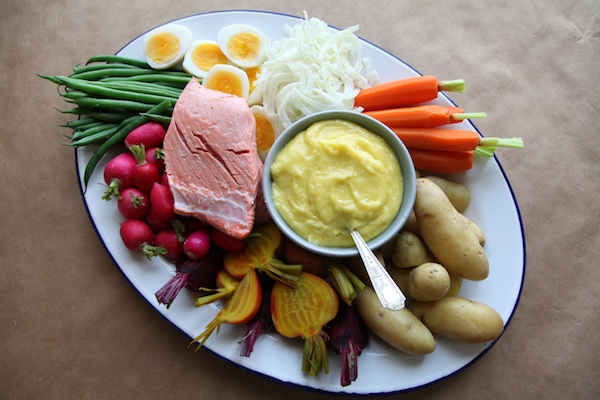
6 to 8 cloves garlic, peeled and minced
1/4 tsp. sea salt or kosher salt
2 large egg yolks
1 C. (250 ml) olive oil
1 C. (250 ml) neutral-tasting vegetable oil
1 to 2 tsp. warm water (optional)
2 large or 3 medium carrots, peeled, halved crosswise, and cut into 1/2-inch-wide sticks
12 oz. (320g) green beans, ends removed
2 pounds (900g) small new potatoes
1 1/2 to 2 pounds salt cod, soaked for 24 hours in the refrigerator, changing the water three times
6 hard-cooked eggs, peeled and halved lengthwise, each topped with an anchovy fillet and a few grinds of black pepper
1 pound (450g) cherry tomatoes
1 large or 2 small (230g) beet(s), peeled and thinly sliced
1 large or 2 small (230 to 28og) kohlrabi, peeled and thinly sliced
2 bunches radishes, trimmed
Toasted or grilled bread To make the aioli, mash the garlic with the salt in a mortar and pestle, then stir in the egg yolks. (The aioli can also be made in a blender or food processor.) Mix the oils in a measuring C. with a spout. Drop by drop, add the oil to the garlic while continuously pounding the pestle to incorporate the oil. (If using a machine, dribble the oil in slowly, in a continuous stream, while the machine is running.) Continue to stir and as the mixture begins to thicken, increase the flow of oil, stirring until all the oil is added. If the aioli is too thick, add the warm water, until it reaches the desired consistency. Cover and let sit at room temperature if you’re planning to serve it shortly. Otherwise refrigerate it. (The aioli will keep for up to 24 hours.) To make the accompaniments, bring a pot of salted water to a low boil. Blanch the carrots for 1 minute. Remove them with a slotted spoon to a baking sheet lined with a kitchen towel. Blanch the green beans in the same water for 3 minutes and remove them to drain next to the carrots. Add the potatoes to the pot and cook for 10 to 15 minutes (depending on size), just until tender—they are done when they can be pierced easily with the tip of a sharp paring knife. Drain in a colander. To cook the salt cod, put the soaked and drained fish in a pot of cold water and bring to a low boil. Let simmer for 15 to 20 minutes, or until soft. Drain and let cool to room temperature. Arrange the remaining accompaniments decoratively on a large serving platter along with the bowl of aioli and let guests help themselves. VARIATION: Though this isn’t traditional, you can substitute a whole, roasted chicken—cut into pieces and served cold—for the salt cod
Acorn Squash, Roasted
Aromatic Snails
Artichokes & Snails
Artichokes (small)
Asparagus
Baby carrots
Beets
Blue Crab Claws
Capers, Fried
Carrot
Cauliflower
Chanterelles
Cherry tomatoes
Chickpea Panisses
Crab
Croquettes
Crusty French Bread
Fennel
Fingerling / New potatoes
Fleur de sel
Fritters
Green beans
Grissini
Hard boiled eggs
Kohlrabi
Leeks
Lettuces
Mussels Steamed in Wine
Niçoise Olives
Octopus Ragout
Poached cod
Pomegranate Seeds
Radish
Romanesco cauliflower
Salt Cod
Scallions
Shrimp
Snap Pea
Snow Peas
Steamed artichokes
Steamed clams or mussels
Turnips
Wax beans
Octopus Ragout
Providing a welcome depth of flavor, this stew is divine and unexpected when paired with aioli.
8 tsp. extra-virgin olive oil
2 large yellow onions, finely chopped
6 garlic cloves, peeled and crushed
3 large tomatoes, seeded and coarsely chopped
Salt and freshly ground black pepper
5 pounds octopus, preferably small ones, cleaned but unskinned, cut into bite-size pieces (see note)
1 large bay leaf
9 tsp. cognac or marc de Provence
¾ C. dry white wine
1/3 C. parsley, roughly chopped
In a large frying pan, warm 5 tsp. oil with onions and garlic. Stirring frequently, cook over low heat until light golden, about 10 minutes. Turn heat to high and add tomatoes and salt and pepper, to taste. Sauté, tossing often, until tomato liquid has evaporated, 5-10 minutes. Meanwhile, in a large heavy sauté pan, heat remaining 3 tsp. oil. Add octopus, bay leaf and salt and pepper, to taste. Stir frequently until liquid thrown off by octopus has come to a full boil. Remove from heat and add cognac. Ignite it. Stir until the flames die down. Bring white wine to a boil in a small saucepan and add it to the octopus. Warm stew over medium heat and boil until reduced by one third, about 10 minutes. Add tomato mixture. Bring back to a boil and then reduce heat to maintain a gentle simmer. Cook uncovered and stir often until octopus is very tender but still resilient, about 50 minutes. Adjust seasoning, garnish with parsley and serve. (Can be served at room temperature.)
Note: To ensure optimum tenderness, octopus should be frozen for at least 24 hours before using and then defrosted in the refrigerator. Once thawed, cut bodies, heads and tentacles into bite-size pieces.
Artichokes and snails:
1 artichoke, 24 to 36 size, with thorns and stems
½ fresh lemon
Kosher salt and freshly ground black pepper to taste
2 tsp. extra-virgin olive oil
12 helix snails (one 7-oz. can), drained, rinsed and dried on paper towel
2 tsp. chopped garlic
1 tsp. chopped shallot
½ C. dry white wine
1 tsp. lemon juice
Cut off top 1 inch of artichoke and trim off leaves until you get down to the light green inner tender leaves. Carefully trim off outside of artichoke bottom and stem, about 1/8 to 1/4 inch. Cut artichoke in half through the stem. Rub liberally with the 1/2 lemon. Scoop out the fuzzy choke with a melon baller, but do not remove too much of the base. Put artichoke in a pot of water with enough salt so the water tastes like seawater. Squeeze juice of the 1/2 lemon into the water, along with the lemon body. Bring to a boil and cook 10 to 15 minutes until artichoke is crisp-tender (when a small knife in center comes out with a slight bit of resistance). Remove from pot and shock in ice water. Drain well. When cool, cut each half into quarters. Place a 10-inch sauté pan over high heat. When hot, add oil. When oil is hot, season snails with salt and pepper and carefully add to oil and sauté 1 minute. Add garlic and shallot and sauté, stirring, 1 minute. Add wine and 1 tsp. lemon juice and cook 2 minutes. Remove snails and reduce liquid to 1/4 C.. Add artichokes and snails back to pan, toss together and adjust seasoning with salt and pepper. Cover pan, remove from heat and keep on the side until finishing the dish.
